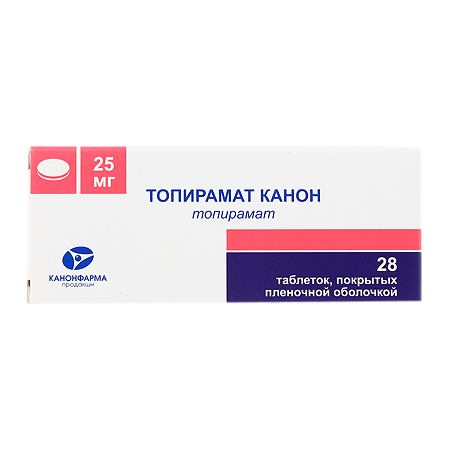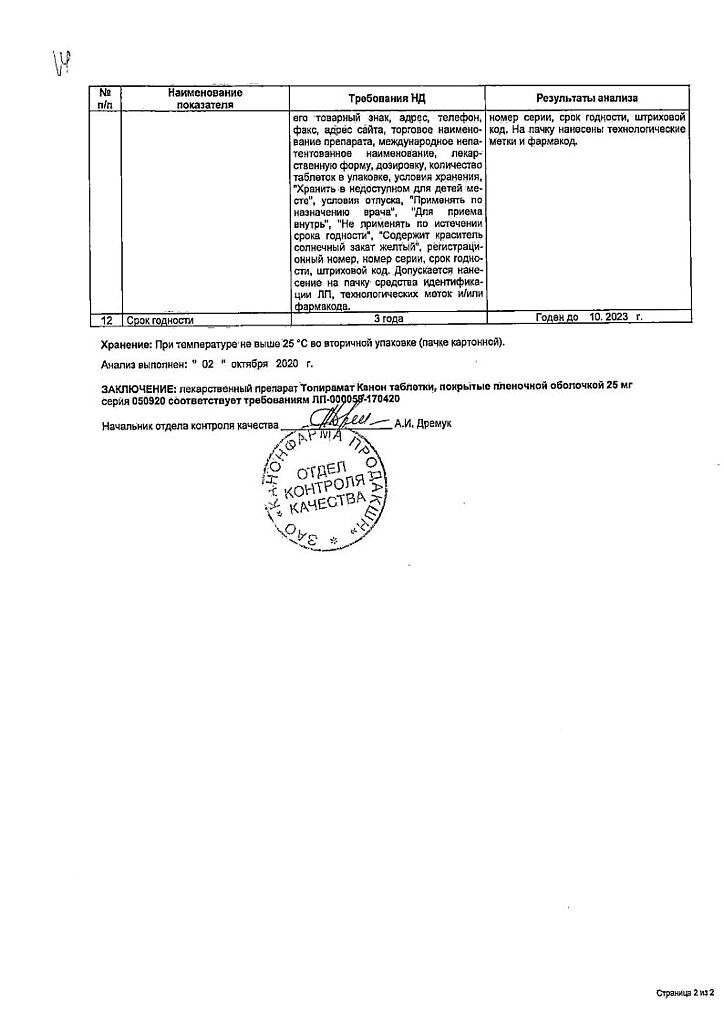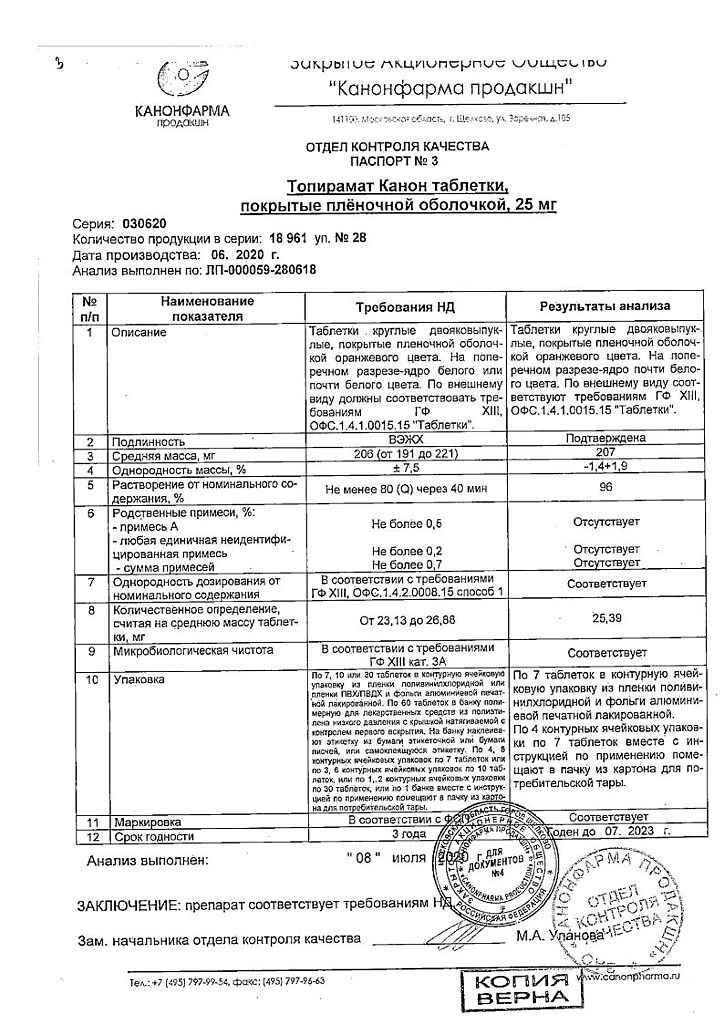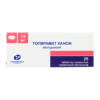No products in the cart.
Topiramate Canon, 25 mg 28 pcs
€8.84 €7.74
Out of stock
(E-mail when Stock is available)
Description
The drug belongs to the class of sulfate-substituted monosaccharides.
Topiramate reduces the frequency of action potentials that are characteristic of the neuron in the state of persistent depolarization, indicating that the drug’s blocking effect on sodium channels depends on the state of the neuron.
This active ingredient potentiates the activity of GABA against several subtypes of GABA receptors (including GABAA receptors), modulates the activity of GABAA receptors themselves, and also prevents kainat activation of kainate/AMPK glutamate receptor sensitivity and has no effect on N-methyl-D-aspartate activity against NMDA receptors. These effects of topiramate are dose-dependent at plasma concentrations of topiramate between 1 μM and 200 μM, with minimal activity between 1 μM and 10 μM.
In addition, topiramate inhibits the activity of some carboanhydrase isoenzymes, but this effect in topiramate is weaker than in acetazolamide and apparently is not central to the antiepileptic activity of topiramate.
Pharmacokinetics
After oral administration topiramate is absorbed quickly and effectively. Bioavailability is 81%. Food intake has no clinically significant effect on the bioavailability of topiramate. Binding to plasma proteins is 13-17%. After a single dose of up to 1.2 g the average Vd is 0.55-0.8 l/kg.
Vd value depends on sex: in women it is about 50% of values observed in men that is associated with a higher content of adipose tissue in women. Pharmacokinetics of topiramate is linear. Plasma clearance remains constant, with AUC in the dose range of 100 to 400 mg increasing in proportion to the dose. Css in plasma is reached in 4-8 days.
After multiple oral doses of 100 mg 2 times/day, Cmax averages 6.76 mcg/ml. After oral administration, about 20% of the administered dose is metabolized.
In plasma, urine and feces, 6 virtually inactive metabolites have been identified. It is excreted mainly by the kidneys unchanged (70%) and as metabolites. Plasma clearance is 20-30 ml/min. After multiple doses of 50 mg and 100 mg twice daily, the T1/2 of topiramate from plasma averages 21 hours.
Indications
Indications
Epilepsy: as a monotherapy for initial treatment in patients over 2 years of age – partial or primary generalized tonic-clonic seizures; as part of complex therapy in patients over 2 years of age – partial or generalized tonic-clonic seizures, as well as seizures associated with Lennox-Gastaut syndrome.
Migraine: prevention of migraine attacks in adults.
Pharmacological effect
Pharmacological effect
The drug belongs to the class of sulfate-substituted monosaccharides.
Topiramate reduces the frequency of action potentials that are characteristic of a neuron in a state of persistent depolarization, which indicates that the blocking effect of the drug on sodium channels depends on the state of the neuron.
This active substance potentiates the activity of GABA in relation to certain subtypes of GABA receptors (including GABAA receptors), modulates the activity of GABAA receptors themselves, and also prevents kainate from activating the sensitivity of kainate/AMPK receptors to glutamate and does not affect the activity of N-methyl-D-aspartate in relation to NMDA receptors. These effects of topiramate are dose-dependent with topiramate plasma concentrations ranging from 1 µM to 200 µM, with trough activity ranging from 1 µM to 10 µM.
In addition, topiramate inhibits the activity of some carbonic anhydrase isoenzymes, but this effect of topiramate is weaker than that of acetazolamide and, apparently, is not the main factor in the antiepileptic activity of topiramate.
Pharmacokinetics
After oral administration, topiramate is absorbed quickly and efficiently. Bioavailability – 81%. Food intake does not have a clinically significant effect on the bioavailability of topiramate. Plasma protein binding is 13-17%. After a single dose in doses of up to 1.2 g, the average Vd is 0.55-0.8 l/kg.
The value of Vd depends on gender: in women it is approximately 50% of the values observed in men, which is associated with a higher content of adipose tissue in the body of women. The pharmacokinetics of topiramate is linear. Plasma clearance remains constant, with AUC increasing dose proportionally over the dose range from 100 to 400 mg. Css in plasma is achieved after 4-8 days.
After repeated oral administration at a dose of 100 mg 2 times/day, Cmax averages 6.76 mcg/ml. After oral administration, about 20% of the dose taken is metabolized.
Six practically inactive metabolites have been identified in human plasma, urine and feces. It is excreted mainly by the kidneys unchanged (70%) and in the form of metabolites. Plasma clearance is 20-30 ml/min. After repeated doses of 50 mg and 100 mg 2 times a day, T1/2 of topiramate from plasma averages 21 hours.
Special instructions
Special instructions
The use of topiramate for the treatment of acute migraine attacks has not been studied.
It should be used with caution in case of renal and liver failure, nephrourolithiasis (including personal and family history), hypercalciuria.
Patients with impaired renal function and patients on hemodialysis require adjustment of the topiramate dosage regimen.
Topiramate should be discontinued gradually to minimize the potential for increased seizure frequency. In clinical studies in adults for the treatment of epilepsy, doses were reduced by 50-100 mg at intervals of 1 week. and by 25-50 mg in adults receiving topiramate 100 mg/day for migraine prophylaxis. In children in clinical studies, topiramate was gradually withdrawn over 2 to 8 weeks. If prompt discontinuation of topiramate is necessary for medical reasons, it is recommended to monitor the patient’s condition.
To reduce the risk of developing nephrolithiasis during treatment, the volume of fluid consumed should be increased.
With the use of topiramate, a decrease in sweating and hyperthermia is possible, especially in young children, in conditions of elevated ambient temperatures. Adequate fluid replacement before and during activities such as exercise or exposure to high temperatures can reduce the risk of heat-related complications.
During the treatment period, it is necessary to monitor the condition of patients in order to identify signs of suicidal idealization and prescribe appropriate treatment. Patients (and, if necessary, caregivers of patients) should be advised to immediately seek medical help if signs of suicidal idealization or suicidal behavior appear.
If any disturbances occur on the part of the organ of vision, incl. syndrome involving myopia associated with angle-closure glaucoma, topiramate should be discontinued as soon as deemed possible by the treating physician. If necessary, measures should be taken to reduce intraocular pressure.
To avoid the occurrence of metabolic acidosis, during treatment with topiramate it is recommended to carry out the necessary studies, including determination of the concentration of bicarbonates in the serum. If metabolic acidosis occurs and persists, it is recommended to reduce the dose or discontinue topiramate. In children, chronic metabolic acidosis can lead to growth retardation. The effect of topiramate on growth and possible complications related to the skeletal system have not been systematically studied in children and adults.
If your body weight decreases during treatment, your diet should be adjusted.
The simultaneous use of other drugs that have a depressant effect on the central nervous system is not recommended.
During the treatment period, the patient should avoid drinking alcohol.
Impact on the ability to drive vehicles and operate machinery
It should be used with caution in patients engaged in potentially hazardous activities that require increased attention and speed of psychomotor reactions, because Topiramate may cause drowsiness, dizziness, and visual disturbances.
Active ingredient
Active ingredient
Topiramate
Composition
Composition
1 film-coated tablet contains:
active substance:
topiramate 25 mg and 100 mg;
excipients:
calcium hydrogen phosphate dihydrate (65 mg, 120 mg),
pregelatinized starch (starch) (70.5 mg, 111 mg),
magnesium hydroxycarbonate heavy (magnesium carbonate heavy) (30 mg, 50 mg),
magnesium stearate (1.5 mg, 3 mg),
povidone (8 mg, 16 mg);
composition of the film shell – Selecoate AQ–02140 (6 mg, 12 mg) [hypromellose (hydroxypropyl methylcellulose), macrogol (polyethylene glycol 400), macrogol (polyethylene glycol 6000), titanium dioxide, sunset yellow dye].
Pregnancy
Pregnancy
Adequate and strictly controlled clinical studies of the safety of topiramate during pregnancy have not been conducted.
Use of topiramate during pregnancy may cause fetal harm. Pregnancy registry data indicate that fetal exposure to topiramate in utero increases the risk of congenital malformations (e.g., craniofacial defects such as cleft lip/cleft palate, hypospadias, and developmental anomalies of various body systems).
These malformations were recorded both during topiramate monotherapy and when it was used as part of combination therapy. Compared with a group of patients not taking antiepileptic drugs, data from the registry of pregnant women with topiramate monotherapy indicate an increase in the frequency of births of children with low body weight (less than 2500 g). A cause-and-effect relationship has not been established.
When treating women of childbearing age, the expected benefits of therapy for the mother should be weighed against the potential risks to the fetus and alternative treatment options should be considered. If topiramate is used during pregnancy or if pregnancy occurs during treatment, the patient should be warned of the potential risk to the fetus.
A limited number of observations suggest that topiramate is excreted in breast milk. If it is necessary to use it during lactation, the issue of stopping breastfeeding should be decided.
Use in children
Do not use in children under 2 years of age.
Contraindications
Contraindications
Hypersensitivity to topiramate.
Use for liver dysfunction
Use with caution in patients with impaired liver function due to a possible decrease in clearance of topiramate.
Side Effects
Side Effects
From the nervous system: paresthesia, drowsiness, dizziness, impaired attention, memory impairment, amnesia, psychomotor disturbances, convulsions, poor coordination, tremor, lethargy, hypoesthesia, nystagmus, dysgeusia, imbalance, articulation disorder, intentional tremor (dynamic), sedation, depression of consciousness, convulsions of the grand mal convulsive type seizures, visual field defect, complex partial seizures, speech disorder, psychomotor hyperactivity, syncope, sensory disturbances, drooling, aphasia, repetitive speech, hypokinesia, dyskinesia, postural vertigo, poor sleep quality, burning sensation, sensory loss, parosmia, cerebellar syndrome, dysesthesia, hypogeusia, stupor, clumsiness, aura, ageusia, dysgraphia, dysphasia, peripheral neuropathy, presyncope, dystonia, apraxia, circadian sleep disorder, hyperesthesia, hyposmia, anosmia, essential tremor, akinesia, lack of response to stimuli, learning difficulties.
Mental disorders: depression, slow thinking, cognitive disorders, insomnia, severe speech impairment, anxiety, confusion, disorientation, aggression, mood lability, anxious arousal, emotional lability, depressed mood, anger, inappropriate behavior, suicidal ideation or attempts, auditory and visual hallucinations, psychotic disorder, apathy, lack of spontaneous speech, disorders sleep, affective lability, decreased libido, anxiety, tearfulness, dysphemia, euphoria, paranoid states, perseveration of thinking, panic attack, tearfulness, impaired reading skills, flattening of emotions, sleep disorder, pathological thinking, loss of libido, lethargy, intrasomnic disorder, pathologically increased distractibility, early awakenings in the morning, panic reaction, mania, panic frustration, feeling of despair, hypomanic state.
From the organ of vision: blurred vision, diplopia, visual impairment, decreased visual acuity, scotoma, myopia, pathological sensations in the eyes, dry eyes, photophobia, blepharospasm, increased lacrimation, photopsia, mydriasis, presbyopia, one-sided blindness, transient blindness, glaucoma, impaired accommodation, impaired visual depth perception, atrial fibrillation scotoma, eyelid edema, night blindness, amblyopia, angle-closure glaucoma, maculopathy, oculomotor disorders.
From the hematopoietic system: anemia, leukopenia, thrombocytopenia, lymphadenopathy, eosinophilia, neutropenia.
From the immune system: hypersensitivity, allergic edema, conjunctival edema.
Metabolism: anorexia, loss of appetite, metabolic acidosis, hypokalemia, increased appetite, polydipsia, hyperchloremic acidosis.
On the part of the organ of hearing and balance: vertigo, tinnitus, ear pain, deafness, one-sided deafness, sensorineural deafness, discomfort in the ears, hearing impairment.
From the cardiovascular system: bradycardia, sinus bradycardia, rapid heartbeat, orthostatic hypotension, flushing, hyperemia, Raynaud’s phenomenon.
From the respiratory system: nasopharyngitis, dyspnea, epistaxis, nasal congestion, rhinorrhea, cough, shortness of breath on exertion, hypersecretion in the paranasal sinuses, dysphonia.
From the digestive system: nausea, diarrhea, vomiting, constipation, upper abdominal pain, dyspepsia, abdominal pain, dry mouth, stomach discomfort, oral paresthesia, gastritis, abdominal discomfort, pancreatitis, flatulence, gastroesophageal reflux disease, lower abdominal pain, oral hypoesthesia, bleeding gums, bloating abdomen, discomfort in the epigastric region, pain throughout the abdomen, hypersecretion of the salivary glands, pain in the oral cavity, bad breath, glossodynia, hepatitis, liver failure.
From the skin and subcutaneous tissues: alopecia, itching, rash, anhidrosis, facial hypoesthesia, urticaria, erythema, generalized itching, macular rash, skin discoloration, allergic dermatitis, facial swelling, Stevens-Johnson syndrome, erythema multiforme, unpleasant skin odor, periorbital edema, localized urticaria, toxic epidermal necrolysis.
From the musculoskeletal system: arthralgia, muscle spasms, myalgia, muscle cramps, muscle weakness, muscle pain in the chest, joint swelling, muscle stiffness, flank pain, muscle fatigue, discomfort in the extremities.
From the urinary system: nephrolithiasis, pollakiuria, dysuria, urinary calculi, stress incontinence, hematuria, painful urgent urge to urinate, renal colic, pain in the kidney area, ureteral calculi, renal tubular acidosis.
From the reproductive system: erectile dysfunction, sexual dysfunction.
General reactions: fatigue, pyrexia, asthenia, irritability, gait disturbance, unusual sensations, malaise, hyperthermia, thirst, flu-like state, inertia, cold extremities, feeling of intoxication, anxiety, facial swelling, calcinosis.
From the laboratory parameters: decrease in body weight, increase in body weight, crystalluria, abnormal tandem gait test, leukopenia, increased activity of liver enzymes, hypokalemia, decreased content of bicarbonates in the blood.
Interaction
Interaction
When used simultaneously with topiramate, phenytoin and carbamazepine reduce its concentration in the blood plasma. This is due to the induction under the influence of phenytoin and carbamazepine of enzymes, with the participation of which the metabolism of topiramate is carried out. In some cases, when using topiramate, an increase in the concentration of phenytoin in the blood plasma was observed.
When a single dose of topiramate and digoxin are used simultaneously, the AUC of digoxin may decrease.
When administered concomitantly with an oral contraceptive containing norethindrone and ethinyl estradiol, topiramate did not significantly affect the clearance of norethindrone, but the plasma clearance of ethinyl estradiol was significantly increased. Thus, when topiramate is taken concomitantly with oral contraceptives, their effectiveness may be reduced.
In patients taking metformin, pioglitazone, glibenclamide, fluctuations in plasma glucose levels are possible with simultaneous use or withdrawal of topiramate. Plasma glucose levels should be monitored with these combinations.
When topiramate is used simultaneously with drugs that predispose to the development of nephrolithiasis, the risk of kidney stones may increase.
Overdose
Overdose
Symptoms: convulsions, drowsiness, speech and vision disorders, diplopia, thinking disorders, coordination problems, dizziness, lethargy, stupor, arterial hypotension, abdominal pain, dizziness, agitation and depression, metabolic acidosis. In most cases, the clinical consequences were not severe, but deaths have been reported after overdose using a mixture of several drugs, including topiramate. There is a known case of an overdose of topiramate in a dose of up to 110 g, which led to coma for 20–24 hours, and then after 3–4 days – complete recovery.
Treatment: there is no specific antidote for the drug; if necessary, symptomatic therapy is carried out. It is necessary to immediately induce vomiting and rinse the stomach, increase water consumption. In vitro studies have shown that activated carbon adsorbs topiramate. Hemodialysis is the most effective way to remove topiramate from the body. Patients are advised to adequately increase their fluid intake.
Storage conditions
Storage conditions
In a dry place, protected from light, at a temperature not exceeding 25 °C
Shelf life
Shelf life
2 years
Manufacturer
Manufacturer
Kanonpharma production CJSC, Russia
Additional information
| Shelf life | 2 years |
|---|---|
| Conditions of storage | In a dry, light-protected place at a temperature not exceeding 25 °C |
| Manufacturer | Kanonfarma Production ZAO, Russia |
| Medication form | pills |
| Brand | Kanonfarma Production ZAO |
Related products
Buy Topiramate Canon, 25 mg 28 pcs with delivery to USA, UK, Europe and over 120 other countries.




















